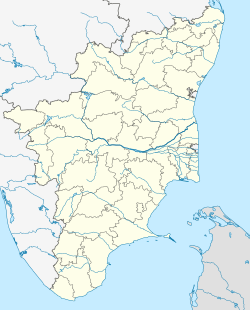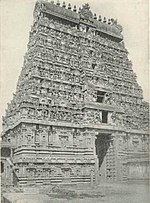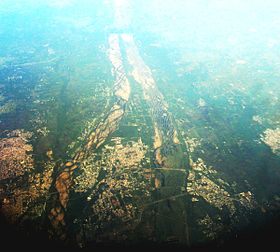world.wikisort.org - India
Srirangam, is a neighbourhood in the city of Tiruchirappalli in the Indian state of Tamil Nadu. A river island, Srirangam is bounded by the Kaveri River on one side and its distributary Kollidam on the other side. Considered as the first among the 108 Divya Desams, Srirangam is home to a significant population of Sri Vaishnavites (followers of Lord Vishnu).
Srirangam
Thiruvarangam | |
|---|---|
Neighbourhood | |
 Aerial view of the Sri Ranganathaswamy Temple in Srirangam | |
| Nickname: City of Antya Ranga | |
 Srirangam  Srirangam | |
| Coordinates: 10.87°N 78.68°E | |
| Country | India |
| State | Tamil Nadu |
| City | Tiruchirappalli |
| Government | |
| • Type | City Municipal Corporation |
| • Body | Tiruchirappalli City Municipal Corporation- Srirangam Zone |
| Elevation | 70 m (230 ft) |
| Population (2001) | |
| • Total | 181,556 |
| Language | |
| • Official | Tamil |
| Time zone | UTC+5:30 (IST) |
| PIN | 620006 |
| Telephone code | 91–431 |
| Vehicle registration | TN-48 |
| Lok Sabha constituency | Tiruchirapalli |
| Legislative Assembly constituency | Srirangam |
| Website | http://srirangam.org/ http://trichycorporation.gov.in |
Sri Ranganathaswamy Temple



Srirangam is famous for its Sri Ranganathaswamy Temple, a major pilgrimage destination for Hindus (especially Srivaishnavites) and the largest temple complex in India.
According to the temple's website, Srirangam is considered the biggest functioning Hindu temple in the world, as it covers an area of about 631,000 square metres (6,790,000 sq ft) with a perimeter of 4 km (10,710 ft).[1] Angkor Wat is bigger but non-functioning.
Srirangam among a few "self-manifested" shrines (Swayam Vyakta Kshetras) of Lord Vishnu. The temple complex is enormous and spans 156 acres (0.63 km2). It has seven prakaras' (enclosures). These enclosures are formed by thick and huge rampart walls which run round the sanctum. There are 21 magnificent towers in all prakaras providing a unique sight to any visitor. The temple town lies on an islet formed by the twin rivers Kaveri and Kollidam.
The Sriranganathaswamy Temple complex is composed of 7 concentric walled sections and 21 towers gopuram.[2] The southern gopuram of the temple, called the Rajagopuram, is 239.5 feet tall and, as of 2016, is the tallest in Asia. The construction of the Rajagopuram began during the reign of Achyuta Deva Raya of the Vijayanagara empire. However, construction was halted after his death and the structure of the Rajagopuram remained incomplete for over 400 years. The monumental task of completion of the Rajagopuram was undertaken and completed successfully by Sri Vedanta Desika Yatheendra Mahadesikan, the 44th jeeyar of Sri Ahobila Matha. The construction spanned 8 years before it was consecrated on 25 March 1987.
The temple has seven prakaras with gopurams articulating the axial hi
th, the highest at the outermost prakara and the lowest at the innermost. In historic times, just after the construction of this temple, the city of Srirangam lived completely within the walls of this temple and hence is quoted as an example of Hindu religious utopia – during its peak of existence.
The Srirangam temple is one of the three temples of the God Ranganatha (Antya Ranga) that are situated in the natural islands formed in the Kaveri river. They are:
- Adi Ranga: the Sri Ranganathaswamy Temple at Srirangapatna, Srirangapatna taluk, Mandya district, Karnataka, India
- Madhya Ranga: the Sri Ranganathaswamy Temple at Shivanasamudra, Kollegala taluk, Chamarajanagara district, Karnataka, India
- Antya Ranga: the Sri Ranganathaswamy Temple at Srirangam, Srirangam taluk, Tiruchirappalli district, Tamil Nadu, India
There is a gopuram fully made of gold, which is protected by an electrical fence. Clothes such as silk sarees, dhoti and towels, which are used for religious purposes are auctioned here.
Ramanuja (11th century), one of the most celebrated theologians of Hinduism, made his monastic home by the temple at Srirangam. Here he wrote his famous commentaries on the Brahma Sutra, which expressed a qualified non-dualism of the Vedanta, his Vishishtadvaita.[3] Ramanuja's body is said to come out of the Earth after he was buried and was preserved at this temple.[4] Although, Ramanujar hailed from Sriperumbudur and a pivotal point in his lifetime, receiving the Ashtakshara mantram, happened in Thirukoshtiyur, he made Srirangam his home after the demise of his Acharya in spirit, Alavanthar or Yamunacharya.
Inside the temple complex, there is a separate temple dedicated to the goddesses Ranganayaki and Andal. Additionally, there is a museum, a library and a bookshop.
Legend
Lord Rama performed aradhanam (pooja) to Vishnu's idol (deity in a reclining posture). As a symbol of love he gave the idol to Vibhishana (brother of Ravana of the Hindu epic Ramayana) to take back with him to Lanka. There was a condition that he could not set the idol on earth and if he did it would seat itself permanently. Vibishan took this idol and while travelling towards Lanka, came upon the banks of the river Kaveri. He placed the idol on banks of river Kaveri, while an utsavam was in progress. When the utsavam got over, the Lord refused to move as he loved the place (Srirangam). When Vibhishan requested him to come along with him, the lord refused but promised to bless Vibhishana by always facing South (the direction of Lanka, home to Vibhishana). Hence it is due this reason the deity (in a reclining posture) faces South. The Chola kings Dharmavarcholan and Killivalavan developed the shrine into the big temple seen now, with contribution of valorous Thirumangai Alvar too. They built the basic foundations and main buildings.
After the rise of Vijayanagara Empire, Krishna Deva Raya realized the importance of this sacred city and treated it on par with Tirupati and bequeathed plenty of treasures, jewels and lands to the Srirangam temple. During his period the Srirangam temple was reformed and many plans were executed for its growth and welfare of the people.
Old Tamil literature refers to the place as Tiruvarangam. The name owes itself to the legend that once the holy vimana (Sriranga Vimana) of Visnu got stuck at this place. An isle lying in the midst of the winding branches of a river is called arangam in Tamil. Thus the spot came to be known as Srirangam in Sanskrit and Tiru-Arangam in Tamil.[5]
Geography
The Kaveri River diverges at the Upper Anaicut, a dam at the island's westernmost point. The Kollidam River, the first and largest distributary of the Kaveri, flows to the north of the island, while the continuation of the Kaveri flows to the island's south. While the Kollidam continues flowing east past the island unimpeded, the Grand Anaicut dams the Kaveri at the island's eastern end, splitting the river into four streams. One stream flows northeast for a short distance, joining the Kollidam and cutting off Srirangam Island on its eastern end. The island is 19 miles (31 km) in length and 1.5 miles (2.4 km) wide. The town of Srirangam, a prominent Hindu Vaishnavite pilgrimage centre, is located at the centre of this island. Most of the island forms part of the Srirangam zone of the Tiruchirappalli Municipal Corporation and includes the suburbs of Srirangam, Thiruvanaikaval, Srinivasa Nagar and Gitapuram.[6]
Economy
Due to the famous temple, Srirangam has a thriving economy based on tourism. Devotees come from all parts of India and abroad. The number of devotees to the town increases greatly during the festivals like Vaikunta Ekadashi which falls on the Tamil month of Marghazi (Margashirsha).
There are many other famous temples near Srirangam. They include Pillaiyar Rockfort temple, Samayapuram Mariamman temple, Tiruvaanaikovil temple, Vayalur Murugan temple, Uraiyur Vekkali Amman temple, Kattu Azhagiya Singar temple etc.[7]
In addition along the banks of Kaveri in areas near Srirangam and Tiruchirappalli there are other famous temples of Lord Vishnu most of which house the reclining form of him, namely the Sri Vadivazhagiya Nambi Perumal Temple (Thiru Anbil) and housing the deity Appala Ranganathar, also called the Appukudaththan Temple at Koviladi.
Another temple of Lord Vishnu is at Tiruchirappalli itself, the Azhagiya Nambi Temple at Woraiyur which is part of the Sri Ranganathaswamy Temple at Srirangam.
Srirangam town is also home to several hundred people who work in offices and industries located in Tiruchirappalli. The public transport linking Srirangam to Tiruchirappalli (route #1) is very frequent.
Education
There are numerous schools, both private and public, in the town. The Higher Secondary School for Boys was founded in 1896 and is the oldest one in the town. There is also a Higher Secondary School for girls which is almost as old as that of the boys.Sri Vageesha Vidhyashram Senior Secondary School, Srimad Andavan College, Chinmaya Vidyalaya Matric. School, Sri Akilandeswari Vidyalaya, Vignesh Sri Ranga Matriculation School, Sri Vaijayanthi Vidhyalaya etc., are other institutions in Srirangam. Most of the schools have English as a medium of instruction. Some have Tamil as a medium of instruction, and some have both. There are many school children who travel to nearby Tiruchirappalli also.
Transport
Air

The nearest airport is Tiruchirappalli International Airport.Tiruchirappalli Airport has connections to Chennai, Singapore, Dubai, Sharjah, Colombo, Kuala Lumpur, Bengaluru and Mumbai .
Rail

Srirangam has a railway station that can be reached from Chennai through any of the major trains travelling in the Chennai-Kanyakumari railway track and the approximate journey time from Chennai is about 5 hours and 10 minutes (320 km). Only selected trains stop at Srirangam and rest at Tiruchirappalli junction. There is bus service from Tiruchirapalli Junction to Srirangam Temple every 5 minutes throughout the day. At night bus frequency is half an hour.
The Tiruchirappalli fort and Tiruchirapalli Junction which are at a distance of 2 km and 7 km respectively, serve as a connection point to many destinations in southern India, such as Thanjavur, Thiruvananthapuram, Chidambaram, Madurai, Tirupati, Tuticorin, Tenkasi, Rameswaram, Kollam, Bengaluru, Coimbatore, Mysuru, Kochi, Kanyakumari and Mangalore. It also connects cities in the western part of India, such as Pune, Surat, Jodhpur, Bikaner and Ahmedabad, and some North Indian cities like New Delhi and Jammu.
Bus

Tiruchirappalli Central bus stand has direct services to most parts of Tamil Nadu. From the bus stand, tourists can avail local buses, taxi and autorickshaws to reach Srirangam.
City Bus service to all places of tourist interest from Central Bus Stand and from Chinthamani - Main Guard Gate Bus Stand (Both in Tiruchirappalli). Tourist taxis and autorickshaws are also available at reasonable rates.
Route No. 1 of the City bus service runs between Srirangam and Central Bus stand. This route starts from Tiruchirappalli Central Bus Stand and goes via Tiruchirappalli Junction Railway Station, Palakkarai Rettai pillaiyar Kovil street, Main Guard Gate, Chatram Bus Stand, Cauvery River Bridge, Mambazha salai, Thiruvanaikkovil and ends at Srirangam Bus Stand near the Srirangam Therkku vaasal (South entrance to the temple).
There is a bus for every 5 minutes and the bus service is round the clock.
Buses TNSTC are originating from Srirangam to various places like Thiruvananthapuram, Chennai, Madurai, Kodaikanal, etc.[8][9][10]
Climate
The climate of Tiruchirappalli (and Srirangam) is Tropical. Average Temperature Range (°C): Summer- Max. 37.1 °C (98.8 °F) Min. 26.4 °C (79.5 °F); Winter- Max. 31.3 °C (88.3 °F) Min. 20.6 °C (69.1 °F); Rainfall: 835 millimetres (32.9 in)
Politics
Srirangam Assembly constituency is a part of the Tiruchirappalli Lok Sabha constituency. The former chief minister of the state Jayalalithaa had represented this constituency.[11] The Mutharaiyar, SC people, and Brahmins play a major role in Srirangam Assembly constituency, as a majority of voters are from this communities.[12]
References
- "Welcome to Sri Ranganathar Swamy Temple". srirangam.org.
- India By Sarina Singh, Joe Bindloss, Paul Clammer, Janine Eberle
- Sarvepalli Radhakrishnan, Indian Philosophy, volume 2 (London: George Allen Unwin 1923, rev'd 1929, 1940, reprint Oxford University 1989, 2006), pp. 659-662, 665-667.
- "Ramanujar body preserved inside Srirangam Temple". Ramanujar's preserved body info.
- Jagannathan, Sarojini (1994). Impact of Śri Rāmānujāçarya on temple worship (1st ed.). Delhi: Nag Publishers. p. 89. ISBN 8170812887.
- https://censusindia.gov.in/2011census/dchb/DCHB_A/33/3313_PART_A_DCHB_TIRUCHIRAPPALLI.pdf [bare URL PDF]
- Kattu Azhagiya Singa Perumal Temple, Sri Rangam, Trichy – Find My Temple – Temples of Tamil Nadu – Thanjavur, Madurai, Thiruvannamalai, Palani, Kumbakonam
- "Srirangam Info Exclusively". Srirangam's Complete Information.
- "List of new routes added by SETC – Part II". tnstc.wordpress.com. 17 October 2012.
- "TNSTC Bus Timings from Srirangam". tnstc.wordpress.com. 24 May 2015.
- "List of Parliamentary and Assembly Constituencies" (PDF). Tamil Nadu. Election Commission of India. Archived from the original (PDF) on 4 May 2006. Retrieved 11 October 2008.
- MADALA, JAYAKUMAR (3 March 2021). "Why both AIADMK and BJP want Srirangam". The New Indian Express.
External links
На других языках
[de] Srirangam
Srirangam (Tamil: ஸ்ரீரங்கம் Srīraṅkam [.mw-parser-output .IPA a{text-decoration:none}ˈsɾiːɾaŋɡʌm]; seltener Tiruvarangam oder Thiruvarangam, Tamil: திருவரங்கம் Tiruvaraṅkam [ˈtiɾɯʋaɾʌŋɡʌm]) ist eine Tempelstadt im südindischen Bundesstaat Tamil Nadu. Sie liegt auf der gleichnamigen Flussinsel zwischen dem Kaveri-Fluss und dessen Seitenarm Kollidam. Verwaltungsmäßig gehört der Ort zur Stadt Tiruchirappalli, deren Zentrum sechs Kilometer südlich auf der anderen Seite des Kaveri-Flusses liegt. Hauptsehenswürdigkeit Srirangams ist der Ranganathaswamy-Tempel, das wichtigste vishnuistische Heiligtum Tamil Nadus und eines der herausragendsten Beispiele für den Dravida-Stil der hinduistischen Tempelbauarchitektur. In unmittelbarer Nachbarschaft befindet sich mit Tiruvanaikkaval ein wichtigest shivaitisches Heiligtum.- [en] Srirangam
[fr] Srirangam
Srirangam écrit aussi Shrirangam (tamoul : ஸ்ரீரங்கம் ; sanskrit IAST : śrīraṅga ; sanskrit : श्रीरंगम), connu également sous le nom de Thiruvarangam, est un temple[1], une île et une zone de la ville de Tiruchirappalli (connue également sous le nom de Trichy ou de Tiruchi), dans le Tamil Nadu, en Inde du Sud.Другой контент может иметь иную лицензию. Перед использованием материалов сайта WikiSort.org внимательно изучите правила лицензирования конкретных элементов наполнения сайта.
WikiSort.org - проект по пересортировке и дополнению контента Википедии
